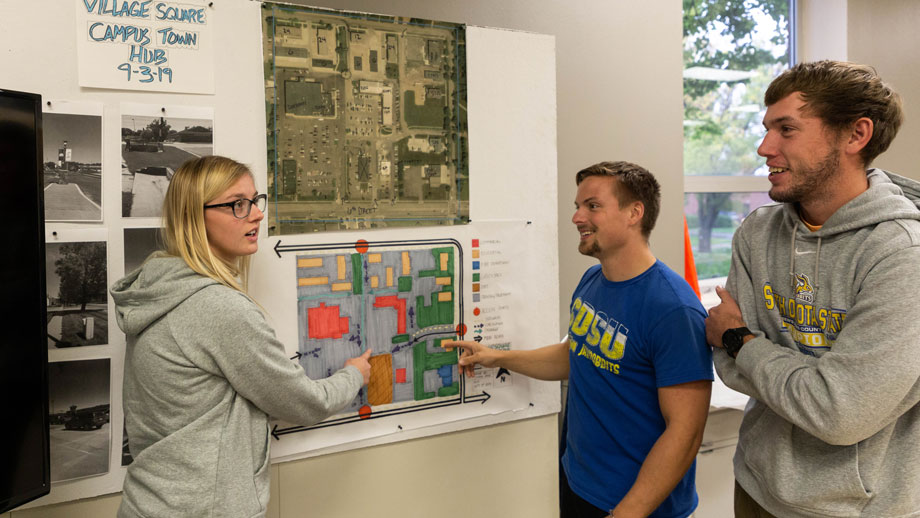Water, water, everywhere—that has been the challenge in Brookings, South Dakota, this summer.
Four faculty researchers in the South Dakota State University School of Design are investigating new ways to manage stormwater that can reduce runoff—and, in the long run, help relieve pressure on the city drainage system.
“Green stormwater infrastructure uses soil and plants to capture water in a distributed, disconnected network of practices throughout the landscape,” said landscape architecture instructor Jeremiah Bergstrom. “It’s about capturing water as close to the source as possible.” That can mean adding native grasses, bushes and trees on the edge of a parking lot, installing a rain garden in the backyard or planting perennials in the boulevard to capture runoff in a residential area.
The goal of the project is to figure out how small rural cities, such as Brookings, can integrate green infrastructure into the existing landscape. The research is made possible through a grant from the California Landscape Architectural Student Scholarship Fund and matching funds from the East Dakota Water Development District.
As part of the project, the landscape architecture program is partnering with SDSU Extension and the Brookings Sustainability Council to host a Stormwater Community Forum 5 p.m. Nov. 14 at the Brookings Activity Center. After a half-hour informal discussion, the researchers will give presentations on what is green infrastructure and how it might be integrated into the city landscape.
“Because this approach utilizes lots of little fixes, engaging city officials and community members is integral to implementing these techniques—and maintaining the structures,” said associate professor Pat Crawford, director of the School of Design. Other members of the team are associate professor Don Burger, a construction expert, and assistant professor Elizabeth Tofte, who works with community development.
Incorporating green infrastructure in a community is “as much a change of attitude as it is a change of practices. If people don’t buy into it, nothing changes,” Crawford said.
Altering city landscape
“Brookings, with its traditional neighborhoods with boulevards, uses historical ways of managing water, which makes the community an ideal study site,” said Crawford, whose expertise is in community development and historic preservation. “In some of the newer subdivisions that have no boulevards, the water is going directly from the roof or driveway to the storm drain.”
During the summer, the researchers analyzed how the city landscape functions, with students gathering information on the physical properties of the soil and determining the rate at which the soil absorbs or filters water. In addition, they looked at the drainage patterns and watersheds along with city’s storm sewer system.
“Managing stormwater is more than just about calculating peak discharge and water volume. It’s also about water quality, when it flows and where it flows,” Bergstrom said. “By developing the landscape, we’ve short-circuited the natural hydrologic cycle. These (green) practices can help restore that cycle.”
Designing green structures
This fall, third-year landscape architecture students in three studio classes are incorporating green structures into the landscaping of several residential homes, the Village Square Center commercial property and the new parking lot on the south side of the Brookings City-County Government Center. The faculty researchers also hope to add a multiunit housing facility to the student design projects.
“The students are creating what-if scenarios,” Bergstrom said. “Students are also learning “what needs to be done to make these tools applicable and appropriate in the landscape given the existing conditions.”
Junior Anthony Miller of Dell Rapids said, “Every town has unique water problems—these green areas serve both functional and aesthetic purposes in a landscape design.”
In her commercial property design, Allie Rea, a junior from Tea, used rain gardens both to capture storm runoff and to serve as a buffer between the street and the sidewalk. Reducing the amount of water flowing over the sidewalk also increases pedestrian safety, she noted.
“It’s important to manage the stormwater on-site rather than simply sending it down the creek,” said junior Kent TeVelde of Lynden, Washington. “Green drainage can help filter pollutants, such as oil and gas, from a parking lot, rather than letting them go down the river. It helps improve the ecosystem,” Donovan Wilson, a junior from Alcester, said.
Bahamas native Garrith Moss sees the use of soil infiltration to capture runoff as something that could be beneficial in low-lying areas on the islands.
The student design projects “will give residents, business, developers and city officials a visual on what the various ‘tools in the green infrastructure toolbox’ could look like,” Bergstrom said. The research project will conclude in December.
Original post https://alertarticles.info
